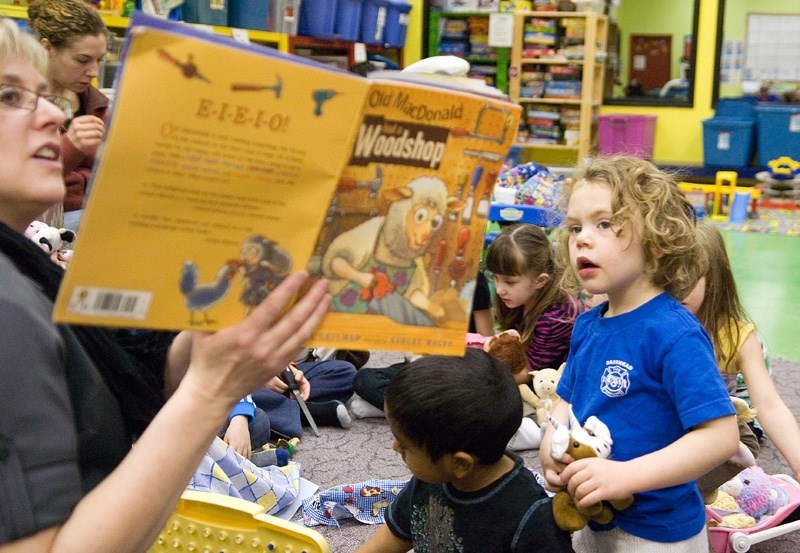For some it is easy to delve into the wonderful world of books where anything can happen and the imagination is free to run wild. Younger children however might have more difficulty keeping their fidgety selves interested in story time, and for these little ones there are story sacks.
What is a story sack exactly? A simple idea that helps a book come alive. The sack, which isn’t necessarily always a literal sack, is filled with objects relating to the story. These objects help children follow along with the story using props and interacting, rather than just sitting and listening.
During story time, whether with one children or 10, the items in the story sack are given out to the eager listeners. As the story progresses, children can involve themselves in the book when their object makes an appearance in the story.
Parent Link in the Barrhead FCSS building celebrated Family Literacy Day by sharing the magic of story sacks with the group. About 14 little ones showed up and participated in story sack time.
Little ones gathered around Parent Link coordinator Rhonda Waggoner to read Old McDonald Had a Woodshop, a twist on the original tale. Each child was given either a farm animal or a toy wood shop tool, and waited for their animal or tool to come up in the story.
Old MacDonald, a sheep running a farm, is building a surprise for the other animals. With the use of a saw, drill, chisel, file, screwdriver, and paintbrush, a cat, goat, chicken, pig, cow and dog help their curly-haired friend with the mysterious creation.
Out came the drill, and the young boy with the matching tool held up his toy drill for the group to see. With a zztt zztt here, and a zztt zztt there, here a zztt, there a zztt, everywhere a zztt zztt. The group sang along with Waggoner, piping up when their goat or cat using a paint brush or screw driver appeared in the story.
Old McDonald’s farm wasn’t the only place the group visited. The kids also journeyed deep into the sea looking for treasure where they met different sea creatures.
A blue sheet represented the deep blue sea, and as the story progressed a variety of sea creatures began to make their way onto the sheet. A killer whale, an octopus, a fish, they all bounced through the water as the children shook the sheet to make waves.
A book about a boy dreaming of a trucking trip with his father also came beautifully to life in the room. A road seen through the windows of a large truck illustrated in the book was skillfully painted on a large piece of cardboard, a toy wheel sitting in front.
Children who wanted to take a drive into the story had the option of wearing different trucker hats and shirts in addition to taking the wheel. Plastic road signs came with this story sack as well, which could be used to either learn the signs of the road or play a matching game.
Ten Little Ladybugs in my Jar, a book written by a woman who struggled with reading late into her adult life, came with a story sack too. This sack was in the form of a jar, and the jar was filled with treasures like a toy car and little stuffed ladybugs.
FCSS Community Development Volunteer Coordinator Ros Rudd said Family Literacy Day is important for children, especially at this age, because reading is the foundation for any learning. They learn language, they learn words, and they learn story. Reading helps with everything from parts of speech, to how to form sentences, individual words and vocabulary.
“As the books get a little more detailed you’re developing story, you’re developing patterning, so when they get into writing they have that knowledge of how to put it all together,” said Rudd. “It’s hard to teach that in a lesson. They need the background.”
Waggoner added children need the play aspect of learning. That’s why, when they come to Parent Link, it’s important they play, interact, and have imaginations. Story sacks are a key example of how children can learn through play.
“That’s part of why story sacks is so important. They’re interacting and playing with the books,” said Waggoner. “Then they can go further than just reading a story. They can act it out, they can play.”
“Once we learn how to play, we can add different methods of learning onto that,” added Rudd. “But we can’t do that until we have the basics.”
Even something so simple as handling the books is important to the development of a young child. Learning how to turn the pages, learning what the front cover is, everything is a piece of the puzzle.
Rudd said if a parent was to ask her what they can do to help their child be successful at school, what that one thing is they cannot miss, it would be reading.
“I would say get your child to love books,” said Rudd. “It’s building background on how to learn. It’s getting those basics for learning.”



